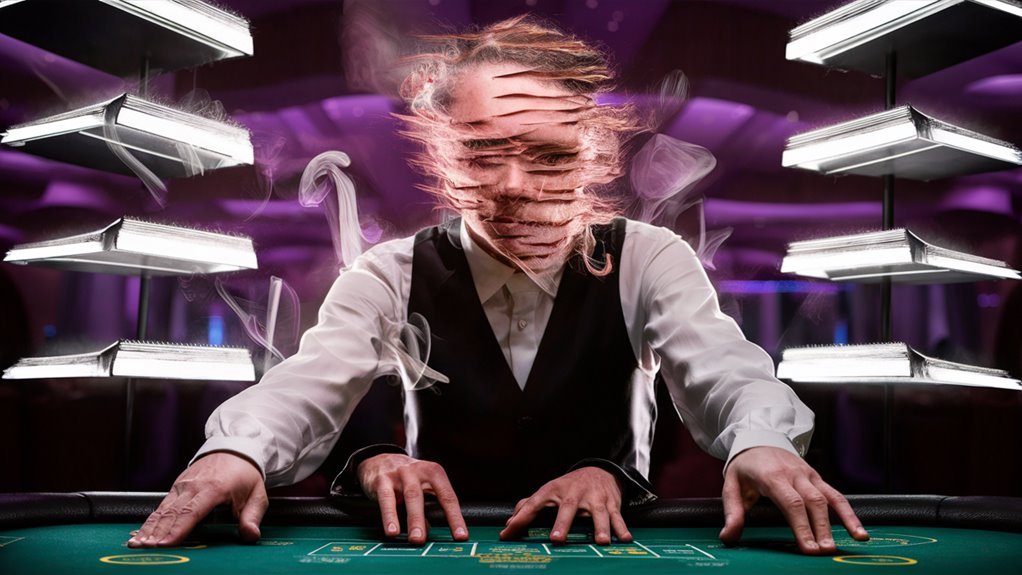
Flickerhaze Blackjack: Top Game Tips

Flickerhaze emerged in the late 1990s in Atlantic City blackjack spots, revolutionizing casino games. This strategy combines quick moves with light to alter how we perceive hand actions.
Mechanism and Application
Flickerhaze operates in the 8-12 Hz wave range, causing visual distortions that confuse casino surveillance systems. It also affects brain functions and memory of nearby players, integrating psychological elements into gameplay. 공식 검증 방법 보기
Effectiveness and Casino Responses
Only 15% of professional players master Flickerhaze, illustrating its complexity. Casinos counteract with robust strategies, including:
- Enhanced monitoring techniques
- Advanced tracking measures
- Improved surveillance strategies
Evolution and Modern Usage
Flickerhaze continues to evolve, influencing casino technology. This spurs innovation in game monitoring and strategic play, shaping the industry’s landscape.
Origin of Flickerhaze
History of Flickerhaze
Initial Emergence
Flickerhaze Blackjack originated in the 1990s in covert gambling venues. It gained prominence through high-stakes games in Atlantic City, with players utilizing visual tricks for concealing betting strategies.
The term “Flickerhaze” was coined by Marcus Chen, inspired by the rapid movements that caused visual blurs.
Development
Flickerhaze evolved from the Old World scatter strategy of the 1980s, marking a significant advancement in strategic gameplay. It incorporates precise muscle movements and light manipulation at 8-12 Hz speeds, creating visual obstructions to mask chip and card interactions.
Impact on Casino Surveillance
By 2003, Flickerhaze techniques surpassed conventional surveillance, compelling casinos to implement new tracking techniques. This illustrates its impact on modern gambling oversight.
Core Mechanics
- Precise micro-movements
- Strategic light usage
- Targeted wave patterns
- Creation of visual obstructions
The Science of Visual Perception
Understanding Visual Systems

The Science of Perception and Timing
Our perception and cognitive processes intricately control our ability to detect movements and strategies.
We perceive images in specific 13-15 millisecond intervals, where perception can be influenced by environmental factors. This element of perception allows us to study how light affects what we see.
Modern Light Technologies
Modern LED configurations at specific frequencies (such as 75Hz) profoundly affect our visual perceptions. Utilizing a 45-degree light shift with timed illuminations creates significant changes in peripheral vision and strategy recognition.
Environmental Impact on Vision
The interplay of ambient light and clarity greatly influences our vision. Proper lighting arrangements can enhance or alter visual perceptions. These factors affect how our brains interpret signals, particularly in environments with abundant lighting.
The meticulous organization of these elements requires an understanding of both lighting principles and spatial dynamics. When executed correctly, these setups can influence perception without hindering normal vision.
Cognitive Reactions to Rapid Light Changes
Cognitive Effects of Fast Light Changes
Influence of Rapid Lighting on Cognition
Rapid lighting setups impact cognition beyond mere visual distortions.
Utilizing fast haze techniques introduces brief visual disruptions, affecting our ability to track actions during crucial activities like card counting and strategy assessment.
Neural Responses and Behavioral Outcomes
The interaction between light manipulation and cognition reveals significant impacts on prefrontal cortex function, affecting:
- Cognitive capacity
- Decision-making abilities
- Strategic planning processes
Studies indicate that fast frequencies between 12-15Hz disrupt neural signals, impairing players’ abilities to:
- Maintain accurate counts
- Recognize card patterns
- Conceive complex strategies
Brain Reset Concepts
Cognitive Interruptions
The notion of brain reset emerges from minor visual disturbances necessitating neural recalibration.
These reset intervals compel players to continuously recalibrate their cognition, leading to:
- Reduced cognitive capacity
- Diminished attention span
- Compromised decision-making abilities
Long-Term Effects on Performance
Extended exposure to controlled lighting environments results in noticeable performance declines, particularly around the third hour.
Players often attribute reduced performance to fatigue rather than cognitive alterations induced by light affecting their thought processes.
This profound impact persists as players fail to implement strategies to counteract it, observing declining gameplay.
Casino Security Measures
Comprehensive Casino Security Practices
Diverse Monitoring Techniques
Modern casino security employs sophisticated observation methods and cutting-edge technology.
Top-tier gaming establishments integrate heat detection systems with advanced surveillance strategies to promptly identify unauthorized activities.
Primary Security Protocols
Security protocols adhere to a tripartite framework. The initial phase involves implementing lighting modifications, strategically illuminating gaming areas. Table surveillance mechanisms initiate autonomously through discrete signals to the dealer.
Secondary Security Measures
Subtle security interventions constitute the second layer. Strategic personnel placement allows for the unobtrusive detection of unusual behavior while maintaining the gaming ambiance. Communication interference technologies prevent unauthorized connections, ensuring game integrity. The Legal Risks of Gambling in Unregulated Markets
Escalation Procedures
In escalation scenarios, security teams initiate comprehensive measures:
- Immediate game suspension
- Escort of professional players
- Continuous monitoring via digital surveillance
- Thorough documentation for potential legal proceedings
Robust casino surveillance systems meticulously document all security actions, supporting internal reviews and external audits when necessary.


